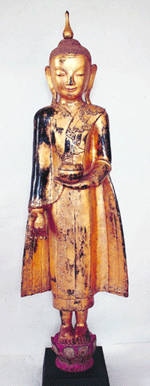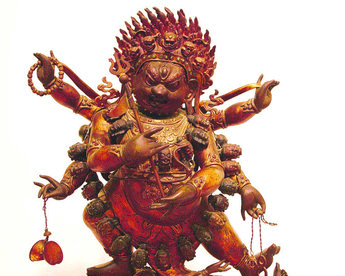 The spiritual dimension of art is on full display in “The Sacred Arts of Asia” exhibit in Towson University’s Asian Arts Gallery.
The spiritual dimension of art is on full display in “The Sacred Arts of Asia” exhibit in Towson University’s Asian Arts Gallery.
One reason why it’s easy to admire the artwork on loan from 14 private collections of paintings and sculpture is that you feel how the beautiful craftsmanship serves a religious purpose.
This exhibit’s curator, John Gilmore Ford, has selected pieces representing various religions from China, Thailand, Korea, Cambodia, Myanmar (formerly known as Burma), Tibet, Pakistan, India, Nepal and Japan. Although the show does not go deep, it certainly does go wide.
That breadth, in this case, is also chronological. Pieces hundreds of years old are installed in close proximity to pieces made in more recent years.
For a very traditional sense of Buddhist art, a good place to contemplate the subject is in front of a gilded lacquer-on-wood statue of a “Burmese Standing Buddha.”
This svelte figure has such a serene smile that your own worries may evaporate as you look it over.
That complete figure definitely makes an impact, but arguably even more moving is a sculptural fragment. A bronze “Buddha’s Hand” is so brusquely cut off at the wrist that it presumably once was attached to a full-size sculpture.
The hand has such elegantly long fingers that they’re simply, er, divine.
Not every sculpted god is calm here. A Chinese glazed pottery “Heavenly King” made during the 16th century represents one of the four heavenly kings guarding the four corners of the universe.
This particular king was believed to bestow wealth, so people today might be just as inclined to worship it.
Stylistically, what’s striking about this ceramic sculpture is that its body is a study in coiled energy, as is its animated face. Also, the surface is brightly colored with Ming blue, yellow and green.
In short, there is nothing subdued about this god.
Lest you think that Buddhism will totally dominate the show, other religions represented include three “Burmese Masked and Antlered Nat Figures.” Although these masks were made during the 20th century, they represent animistic spirits whose worship predates Buddhism in that country.
It’s interesting to see that the masks have human faces on the bottom and antler-topped supernatural faces on top.
Besides the assorted gods on display, humanity makes a direct appearance in works including an ink and color on silk “Japanese Painting of an Abbot” made in 1640.
This bald, seated figure is so confidently peaceful that you’ll want to enroll in his course of study.

These religious works of art are on display in an art gallery, but it’s good to remember that they originally resided in shrines, homes and other buildings.
A simulated Tibetan shrine gives a sense of how sacred paintings and objects would have been placed in close proximity.
Also serving a quasi-architectural purpose is a carved wood “Nepalese Kubera” made in the 16th or 17th century.
Representing a protective deity known as a Kubera, this intricately carved figurative panel originally was used as a suspended banner in a temple.
In addition to all of this venerable old artwork, the exhibit includes its share of contemporary pieces. They’re generally not nearly as compelling as the older work, but some of them are of visual interest.
The most engaging recent piece is an oil painting on canvas titled “Happy Home by Gade” that was made in Tibet in 2003. The deliberately worn and faded surface makes it look like an ancient painting, and similarly you can make out clusters of sacred figures.
However, this densely populated composition also includes depictions of airplanes, cars and even a woman in a bikini. It’s tempting to think that this eclectic gathering would put a smile on the Buddha’s face.
“The Sacred Arts of Asia” runs through May 15 at Towson University’s Asian Arts Gallery, in the Center for the Arts at Osler and Cross Campus drives. Call 410-704-2807 or go to www.towson.edu/asianarts.
Author : Mike Giuliano
Source : http://www.explorehoward.com




